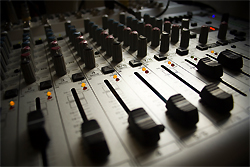You know the feeling…
You pop in your latest mix to play it for a friend.
And as SOON as the mix starts playing, you want to crawl into a hole and disappear. “I swear this sounded better in my studio,” you tell yourself.
You start making excuses, trying to figure out why this mix you were so proud of 60 seconds ago is now embarrassing the crap out of you.
We’ve all been there.
Heck, I still go there occasionally. :>)
And sadly there’s no magic pill to prevent it from happening, but there IS one technique that works, although it’s kinda boring.
What is it?
Use a reference track while mixing.
See? I told you it was boring. But stick with me…
(If you’re unfamiliar with this, I’m referring to comparing your mix to a professional mix WHILE you’re mixing.)
This is probably the single greatest tool for snapping yourself out of the clouds of “I’m the best mix engineer to ever grace this planet” to “Oh, crap, this mix needs some serious work.”
Why? Because it IMMEDIATELY lets you compare your precious mix with a professional mix, one that you KNOW sounds good.
Pick a song that you love, one that has a similar sound to the one you’re working on, and make it a habit to constantly flip back and forth between your mix and the reference track.
This can save you hours of working in the wrong direction, and it can help you get better mixes.
All you have to do is make your mix sound like the reference mix. Easy, right? :>)
No, it’s definitely not. But without a reference mix, you’re simply mixing based on what you THINK sounds good at the time. The reference track gives you a direct line back to reality. It keeps you grounded.
There are a bunch of ways to pull this off. Here’s how I do it. I loop a song in iTunes, then run it to a stereo channel on my mixer. Then I run the output of my DAW to another stereo track.
Then I just use the mute buttons to instantly flip back and forth between the reference and the mix.
Like I said, it’s not exciting, and it’s something I tend to forget to do, but it ALWAYS pays off when I remember.
The problem? Making your mix sound like the reference track isn’t easy, and it’s dang near impossible if you don’t know how to use the tools you have available to you.
Tools like EQ.
Master the use of EQ, and you’ll be well on your way to mixes that, rather than embarrassing you, will make you proud.
Joe Gilder is a Nashville-based engineer, musician, and producer who also provides training and advice at the Home Studio Corner.Note that Joe also offers highly effective training courses, including Understanding Compression and Understanding EQ.





















